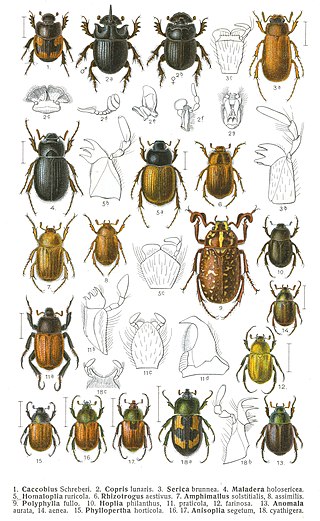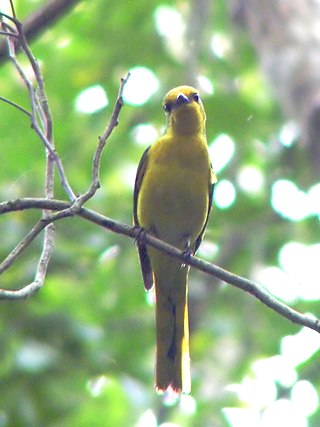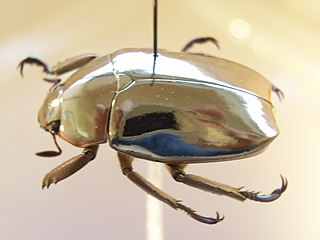
Cetonia aurata, called the rose chafer or the green rose chafer, is a beetle, 20 millimetres long, that has a metallic structurally coloured green and a distinct V-shaped scutellum. The scutellum is the small V-shaped area between the wing cases; it may show several small, irregular, white lines and marks. The underside of the beetle has a coppery colour, and its upper side is sometimes bronze, copper, violet, blue/black, or grey.

The family Scarabaeidae, as currently defined, consists of over 35,000 species of beetles worldwide; they are often called scarabs or scarab beetles. The classification of this family has undergone significant change. Several groups formerly treated as subfamilies have been elevated to family rank, and some reduced to lower ranks. The subfamilies listed in this article are in accordance with those in Catalog of Life (2023).

The minivets are passerine birds belonging to the genus Pericrocotus in the cuckooshrike family Campephagidae. There are about 15 species, occurring mainly in forests in southern and eastern Asia. They are fairly small, slender birds with long tails and an erect posture. Many species have bright red or yellow markings. They feed mainly on insects, foraging in groups in the tree canopy.

Euphoria is a genus of scarab beetles in the subfamily Cetoniinae, the flower or fruit chafers. They are native to the Americas, where they are distributed from Canada to Argentina. They are most diverse in Mexico and Central America. As of 2012, there are 59 species in the genus.

Flower chafers are a group of scarab beetles comprising the subfamily Cetoniinae. Many species are diurnal and visit flowers for pollen and nectar, or to browse on the petals. Some species also feed on fruit. The group is also called fruit and flower chafers, flower beetles and flower scarabs. There are around 4,000 species, many of them still undescribed.

Phyllophaga is a very large genus of New World scarab beetles in the subfamily Melolonthinae. Common names for this genus and many other related genera in the subfamily Melolonthinae are May beetles, June bugs, and July beetles. They range in size from 12 to 35 mm and are blackish or reddish-brown in colour, without prominent markings, and often rather hairy ventrally. These beetles are nocturnal, and are attracted to artificial lights in great numbers.

The punctate flower chafer or spotted flower chafer, Neorrhina punctata, is a species of flower chafer. The chafers are beetles of subfamily Cetoniinae in the large scarab beetle family (Scarabaeidae). Among the chafers, N. punctatum belongs to the tribe Schizorhinini.

Macrodactylus subspinosus is a North American beetle of the family Scarabaeidae. The members of its genus are known as "rose chafers", not to be confused with the European rose chafer, Cetonia aurata. M. subspinosus occurs from Eastern Canada to Colorado and is considered a pest of many crops and flowers. It is given its common name of rose chafer because it eats the leaves of roses, although it also feeds on many other plants.

The little minivet, also known as the Flores minivet, is a species of bird in the family Campephagidae. It is endemic to Indonesia. Its natural habitat is subtropical or tropical moist lowland forest.

Trichiotinus piger, the hairy flower chafer or bee-like flower scarab, is a species of beetle in the family Scarabaeidae.

Pachnoda sinuata, the garden fruit chafer or checkers tor or brown-and-yellow fruit chafer, is a species of beetle found in Namibia, South Africa and Egypt.

Eupoecila australasiae, commonly known as the fiddler beetle or rose chafer, is a colourful green- or yellow-and-black member of the scarab beetle family from eastern Australia.

Gametis jucunda, the smaller green flower chafer, is a species of flower chafer found in Japan. It has been known to damage citrus and other plants.

Rutelinae or shining leaf chafers is a subfamily of the scarab beetles. It is a very diverse group; distributed over most of the world, it contains some 200 genera with over 4,000 described species in 7 tribes. Several taxa have yet to be described. A few recent classifications include the tribe Hopliini, but this is not generally accepted.

Argyripa is a genus of flower chafer belonging to the family Scarabaeidae.

Trichostetha capensis, also known as the brunia beetle and the Cape Protea chafer, is an afrotropical species of flower scarab beetle endemic to South Africa, where it occurs in the Cape Floristic Region.

Trichiotinus is a genus of fruit and flower chafers in the family Scarabaeidae. There are about 8 described species in Trichiotinus, all native to the New World.
Eudicella frontalis is a beetle which belongs to the group of flower chafers in the superfamily Scarabaeoidea.

Protaetia alboguttata is a species of flower chafer found in India, Nepal and Sri Lanka.


















